Reevaluating Mare Moscoviense And Its Vicinity Using Chang’e-2 Microwave Sounder Data
Abstract
1. Introduction
2. Brightness Temperature of the Lunar Regolith
3. Methods and Data Processing
3.1. CELMS Data
3.2. TB Maps Generation
3.3. Image Analysis
3.4. Maximum Likelihood Classification
4. Results
4.1. Noontime TB Features
4.2. Nighttime TB Features
4.3. dTB Features
5. Discussion
5.1. A New View of Basaltic Units
5.2. Warm TB Anomaly
5.3. Revealed Special Terrains
5.4. Homogeneity of Lunar Highlands
6. Conclusions
Author Contributions
Funding
Acknowledgments
Conflicts of Interest
References
- Wilhelms, D.E. The Geological History of the Moon; United States Geological Survey: Washington, DC, USA, 1987; p. 1348.
- Gillis, J.J. The Composition and Geological Setting of Mare Deposits on the Far Side of the Moon. Ph.D. Thesis, Rice University, Houston, TX, USA, 1998. [Google Scholar]
- Jolliff, B.L.; Gillis, J.J.; Haskin, L.A.; Korotev, R.L.; Wieczorek, M.A. Major lunar crustal terranes: Surface expressions and crust-mantle origins. J. Geophys. Res. 2000, 105, 4197–4216. [Google Scholar] [CrossRef]
- Head, J.W. Orientale multi-ringed basin interior and implications for the petrogenesis of lunar highland samples. Earth Moon Planet. 1974, 11, 327–356. [Google Scholar] [CrossRef]
- Ishihara, Y.; Goossens, S.; Matsumoto, K.; Noda, H.; Araki, H.; Namiki, N.; Hanada, H.; Iwata, T.; Tazawa, S.; Sasaki, S. Crustal thickness of the Moon: Implications for farside basin structures. Geophys. Res. Lett. 2009, 36, 82–90. [Google Scholar] [CrossRef]
- Wieczorek, M.A.; Neumann, G.A.; Nimmo, F.; Kiefer, W.S.; Taylor, G.J.; Melosh, H.J.; Phillips, R.J.; Solomon, S.C.; Andrews-Hanna, J.C.; Asmar, S.W.; et al. The Crust of the Moon as Seen by GRAIL. Science 2013, 339, 671–675. [Google Scholar] [CrossRef]
- Namiki, N.; Iwata, T.; Matsumoto, K.; Hanada, H.; Noda, H.; Goossens, S.; Ogawa, M.; Kawano, N.; Asari, K.; Tsuruta, S.; et al. Farside gravity field of the Moon from four-way Doppler measurements of SELENE (Kaguya). Science 2009, 323, 900–905. [Google Scholar] [CrossRef]
- Gillis-Davis, J.J.; Lucey, P.G.; Hawke, B.R. Mare Moscoviense a window into the interior of the Moon. In Proceedings of the 37th Annual Lunar and Planetary Science Conference, Houston, TX, USA, 13–17 March 2006. [Google Scholar]
- Kramer, G.Y.; Jolliff, B.L.; Neal, C.R. Distinguishing high-alumina mare basalts using Clementine UVVIS and Lunar Prospector GRS data: Mare Moscoviense and Mare Nectaris. J. Geophys. Res. Planet. 2008, 113, 769–775. [Google Scholar] [CrossRef]
- Craddock, R.A.; Robinson, M.S.; Hawke, B.R.; McEwen, A.S. Clementine-based geology of the Moscoviense Basin, lunar farside. In Proceedings of the Lunar and Planetary Science Conference, Houston, TX, USA, 17–21 March 1997. [Google Scholar]
- Morota, T.; Haruyama, J.; Honda, C.; Ohtake, M.; Yokota, Y.; Kimura, J.; Matsunaga, T.; Ogawa, Y.; Hirata, N.; Demura, H.; et al. Mare volcanism in the lunar farside Moscoviense region: Implication for lateral variation in magma production of the Moon. Geophys. Res. Lett. 2009, 33, 272–277. [Google Scholar] [CrossRef]
- Thaisen, K.G.; Head, J.W.; Taylor, L.A.; Kramer, G.Y.; Isaacson, P.; Nettles, J.; Petro, N.; Pieters, C.M. Geology of the Moscoviense Basin. J. Geophys. Res. Planet. 2011, 116, E00G07. [Google Scholar] [CrossRef][Green Version]
- Pieters, C.M.; Besse, S.; Boardman, J.; Buratti, B.; Cheek, L.; Clark, R.N.; Combe, J.P.; Dhingra, D.; Goswami, J.N.; Green, R.O.; et al. Mg-spinel lithology: A new rock type on the lunar farside. J. Geophys. Res. Planet. 2011, 116, E00G08. [Google Scholar] [CrossRef]
- Bhatt, M.; Wöhler, C.; Dhingra, D.; Thangjam, G.; Rommel, D.; Mall, U.; Bhardwaj, A.; Grumpe, A. Compositional studies of Mare Moscoviense: New perspectives from Chandrayaan-1 VIS-NIR data. Icarus 2008, 303, 149–165. [Google Scholar] [CrossRef]
- Campbell, B.A.; Carter, L.M.; Hawke, B.R.; Campbell, D.B.; Ghent, R.R. Volcanic and impact deposits of the moon’s aristarchus plateau: A new view from earth-based radar images. Geology 2008, 36, 135–138. [Google Scholar] [CrossRef]
- Fang, T.; Fa, W.Z. High frequency thermal emission from the lunar surface and near surface temperature of the Moon from Chang’E-2 microwave radiometer. Icarus 2014, 232, 34–53. [Google Scholar] [CrossRef]
- Meng, Z.G.; Hu, S.; Wang, T.X.; Li, C.; Cai, Z.C.; Ping, J.S. Passive microwave probing mare basalts in Mare Imbrium using CE-2 CELMS data. IEEE J STARS 2018, 11, 3097–3104. [Google Scholar] [CrossRef]
- Meng, Z.G.; Wang, Y.Z.; Chen, S.B.; Zheng, Y.C.; Shi, J.C.; Wang, T.X.; Zhang, Y.Z.; Ping, J.S.; Hou, L.L. MTE features of Apollo Basin and its significance in understanding the SPA Basin. IEEE J STARS 2019, 12, 2575–2583. [Google Scholar] [CrossRef]
- Lucey, P.G.; Blewett, D.T.; Jolliff, B.L. Lunar iron and titanium abundance algorithms based on final processing of Clementine ultraviolet-visible images. J. Geophys. Res. Planet. 2000, 105, 20297–20305. [Google Scholar] [CrossRef]
- Meng, Z.G.; Zhang, J.D.; Tang, Z.S.; Ping, J.S.; Cai, Z.C. Microwave thermal emission features of Mare Orientale revealed by CELMS data. IEEE J STARS 2017, 10, 2991–2998. [Google Scholar] [CrossRef]
- Zhu, Y.C.; Zheng, Y.C.; Fang, S.B.; Zou, Y.L.; Pearson, S. Analysis of the brightness temperature features of the lunar surface using 37 GHz channel data from the Chang’E-2 microwave radiometer. Adv. Space Res. 2019, 63, 750–765. [Google Scholar] [CrossRef]
- Hagfors, T. Microwave Studies of Thermal Emission from the Moon. Adv. Astronomy Astrophys. 1971, 8, 1–28. [Google Scholar]
- Keihm S, J. Effects of subsurface volume scattering on the lunar microwave brightness temperature spectrum. Icarus 1982, 52, 570–584. [Google Scholar] [CrossRef]
- Keihm S, J. Interpretation of the lunar microwave brightness temperature spectrum: Feasibility of orbital heat flow mapping. Icarus 1984, 60, 568–589. [Google Scholar] [CrossRef]
- Jin, Y.Q.; Yan, F.H.; Liang, Z.C. Simulation for remote sensing of the lunar soil and rock by using multi-channels microwave radiometers. Chin. J. Radio Sci. 2003, 18, 477–486. [Google Scholar]
- Wang, Z.Z.; Li, Y.; Jiang, J.S.; Li, D.H. Lunar surface dielectric constant, regolith thickness, and 3He abundance distributions retrieved from the microwave brightness temperatures of CE-1 Lunar Microwave Sounder. Sci. China Earth Sci. 2010, 53, 1365–1378. [Google Scholar] [CrossRef]
- Heiken, G.H.; Vaniman, D.T.; French, B.M. Lunar Sourcebook: A User’s Guide to the Moon; Cambridge University Press: London, UK, 1991. [Google Scholar]
- Meng, Z.G.; Chen, S.B.; Edward, M.O.; Wang, Z.J.; Cui, T.F. Research on water ice content in Cabeus crater using the data from the microwave radiometer onboard Chang’e-1 satellite. Sci. China Phys. Mech. 2010, 53, 2172–2178. [Google Scholar] [CrossRef]
- Meng, Z.G.; Wang, Q.S.; Wang, H.H.; Wang, T.X.; Cai, Z.C. Potential Geological Significances of Hertzsprung Basin Revealed by CE-2 CELMS Data. IEEE J. STARS 2018, 11, 3713–3720. [Google Scholar]
- Cai, Z.; Lan, T. Lunar Brightness Temperature Model Based on the Microwave Radiometer Data of Chang’E-2. IEEE Trans. Geosci. Remote 2017, 55, 5944–5955. [Google Scholar] [CrossRef]
- Meng, Z.G.; Xu, Y.; Zheng, Y.C.; Zhu, Y.C.; Jia, Y.; Chen, S.B. Inversion of lunar regolith layer thickness with CELMS data using BPNN method. Planet. Space Sci. 2014, 101, 1–11. [Google Scholar] [CrossRef]
- Ulaby, F.T.; Moore, R.K.; Fung, A.; Feng, J.C. Microwave Remote Sensing; Addison-Wesley: Reading, MA, USA, 1981; pp. 51–61. [Google Scholar]
- Jiang, J.S.; Wang, Z.Z.; Zhang, X.H.; Zhang, D.H.; Li, Y.; Lei, L.Q.; Zhang, W.G.; Cui, H.Y.; Guo, W.; Li, D.H.; et al. China probe CE -1 unveils world first Moon -globe microwave emission map-the microwave Moon some exploration results of Chang’E-1 microwave sounder. Remote Sens. Technol. Appl. 2009, 4, 409–422. [Google Scholar]
- Meng, Z.G.; Yang, G.D.; Cai, Z.C.; Gusev, A.; Osei, E.M. Influence of (FeO+TiO2) abundance on the microwave thermal emissions of lunar regolith. Sci. China Earth Sci. 2016, 59, 1498–1507. [Google Scholar] [CrossRef]
- Chan, K.L.; Tsang, K.T.; Kong, B.; Zheng, Y.C. Lunar regolith thermal behavior revealed by Chang’E-1 microwave brightness temperature data. Earth Planet. Sci. Lett. 2010, 295, 287–291. [Google Scholar] [CrossRef]
- Zheng, Y.C.; Tsang, K.T.; Chan, K.L.; Zou, Y.L.; Zhang, F.; Ouyang, Z.Y. First microwave map of the Moon with Chang’E-1 data: The role of local time in global imaging. Icarus 2012, 219, 194–210. [Google Scholar] [CrossRef]
- Hu, G.P.; Chen, K.; Huang, Q.; Guo, W.; Li, Q.; Cheng, Y. Brightness Temperature Calculation of Lunar Crater: Interpretation of Topographic Effect on Microwave Data from Chang’E. IEEE Trans. Geosci. Remote 2014, 52, 4499–4510. [Google Scholar]
- Kerle, N.; Janssen, L.L.F.; Huumeman, G.C. Principles of Remote Sensing; The International Institute for Geo-information Science and Earth Observation (ITC): Enschede, The Netherlands, 2009. [Google Scholar]
- Zhu, W.Q.; Lin, W.P. Remote Sensing Digital Image Processing; Higher Education Press: Beijing, China, 2015. [Google Scholar]
- Bandfield, J.L.; Ghent, R.R.; Vasavada, A.R.; Paige, D.A.; Lawrence, S.J.; Robinson, M.S. Lunar surface rock abundance and regolith fines temperatures derived from LRO Diviner Radiometer data. J. Geophys. Res. Planet. 2011, 116, E00H02. [Google Scholar] [CrossRef]
- Blewett, D.T.; Coman, E.I.; Hawke, B.R.; Gillis-Davis, J.J.; Purucker, M.E.; Hughes, C.G. Lunar swirls: Examining crustal magnetic anomalies and space weathering trends. J. Geophys. Res. Planet. 2011, 116, E02002. [Google Scholar]
- Meng, Z.G.; Li, X.Y.; Chen, S.B.; Zheng, Y.C.; Shi, J.C.; Wang, T.X.; Zhang, Y.Z.; Ping, J.S.; Lu, Y. Thermophysical Features of Shallow Lunar Crust Demonstrated by Typical Copernican Craters Using CE-2 CELMS Data. IEEE J. STARS 2019, 12, 2565–2574. [Google Scholar] [CrossRef]
- Gong, X.H.; Jin, Y.Q. Diurnal change of thermal emission with “hot spots” and “cold spots” of fresh lunar craters observed by Chinese Chang’E-1. Sci. China Inf. Sci. 2012, 42, 923–935. [Google Scholar]
- Meng, Z.G.; Wang, H.H.; Li, X.Y.; Wang, T.X.; Cai, Z.C.; Ping, J.S.; Fu, Z. Potential geological significations of Crisium Basin revealed by CE-2 CELMS data. ISPRS 2018, 42, 1279–1284. [Google Scholar] [CrossRef]
- Arya, A.S.; Rajasekhar, R.P.; Thangjam, G.; Ajai, K.; Kumar, A.S.K. Detection of potential site for future human habitability on the moon using chandrayaan-1 data. Curr. Sci. 2011, 100, 524–529. [Google Scholar]
- Hiesinger, H.; Head, J.W., III; Wolf, U.; Jaumann, R.; Neukum, G. Lunar mare basalt flow units: Thickness determined from crater size-frequency distributions. Geophys. Res. Lett. 2002, 29, 1248. [Google Scholar] [CrossRef]
- Hiesinger, H.; Jaumann, R.; Neukum, G.; Head, J.W. Ages of mare basaltson the lunar nearside. J. Geophys. Res.Planet. 2000, 105, 29239–29275. [Google Scholar] [CrossRef]
- Spudis, P.D.; Mcgovern, P.J.; Kiefer, W.S. Large shield volcanoes on the Moon. J. Geophys. Res. Planet. 2013, 118, 1063–1081. [Google Scholar] [CrossRef]
- Pieters, C.M. Compositional diversity and stratigraphy of the lunar crust derived from reflectance spectroscopy. In Remote Geochemical Analysis: Elemental and Mineralogical Composition; Pieters, C., Englert, P., Eds.; Cambridge Univ. Press: Cambridge, UK, 1993; pp. 309–339. [Google Scholar]
- Tompkins, S.; Pieters, C.M. Mineralogy of the lunar crust: Results from Clementine. Meteorit. Planet. Sci. 1999, 34, 25–41. [Google Scholar] [CrossRef]
- Wu, Y.Z.; Xue, B.; Zhao, B.C.; Lucey, P.G.; Chen, J.; Xu, X.S.; Li, C.L.; Ouyang, Z.Y. Global estimates of lunar iron and titanium contents from the Chang’E-1 IIM data. J. Geophys. Res. Planet. 2012, 117, E02001. [Google Scholar] [CrossRef]
- Yue, Z.Y.; Johnson, B.C.; Minton, D.A.; Melosh, H.J.; Di, K.C.; Hu, W.; Liu, Y. Projectile remnants in central peaks of lunar impact craters. Nat. Geosci. 2013, 6, 435–437. [Google Scholar] [CrossRef]
- Meng, Z.G.; Wang, H.H.; Zheng, Y.C.; Miyamoto, H.; Cai, Z.C.; Ping, J.S. Several Geological Issues of Schrödinger Basin Exposed by CE-2 CELMS Data. Adv. Astron. 2019, 2019, 3926082. [Google Scholar] [CrossRef]
- Meng, Z.G.; Wang, H.H.; Chen, S.B.; Ping, J.S.; Huang, Q.; Cai, Z.C.; Wu, Y.Z. Potential Geologic Issues of Von Karman Crate Revealed by Multisource Remote Sensing Data. ISPRS 2019, XLII–2/W13, 1425–1430. [Google Scholar] [CrossRef]
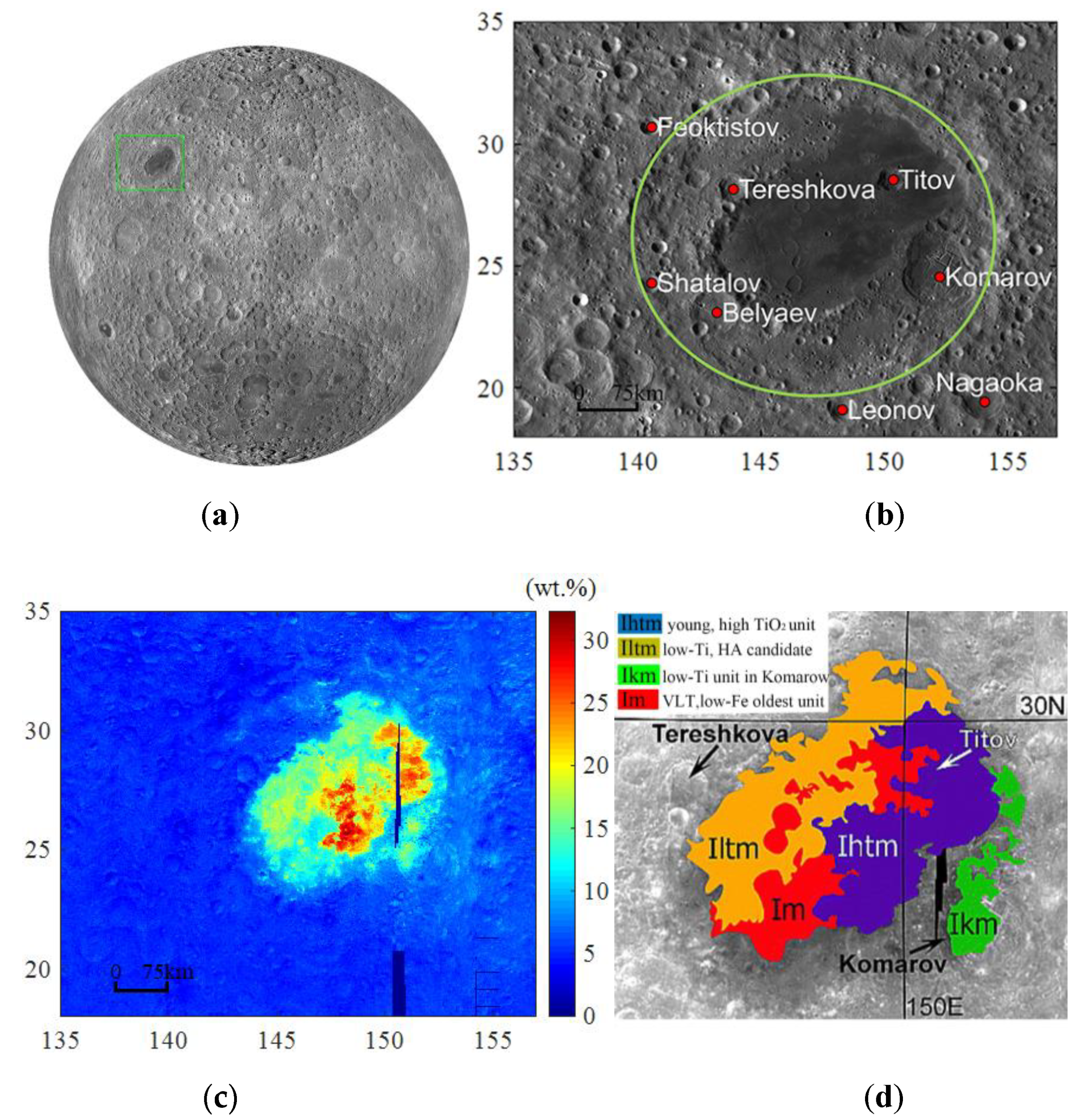
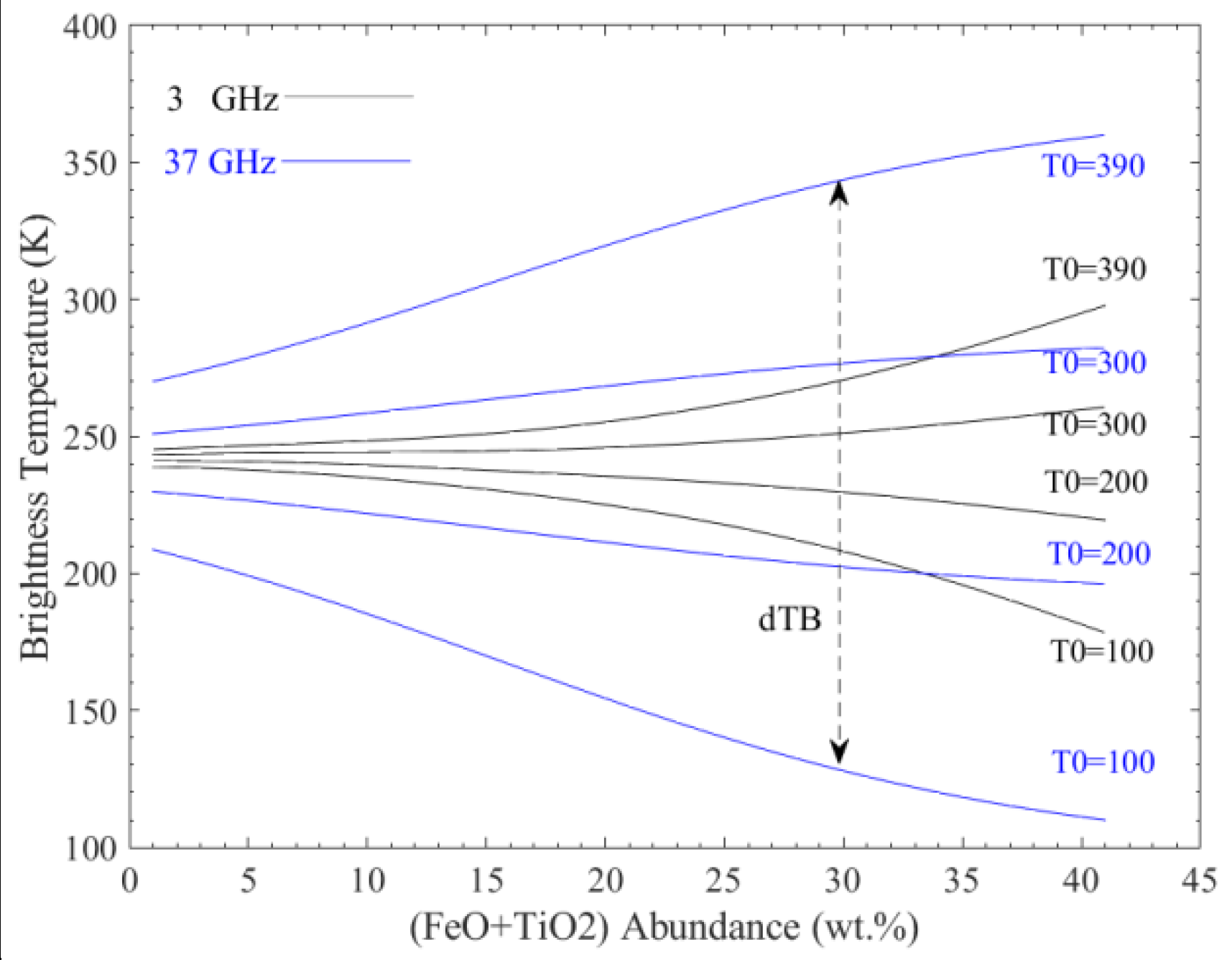
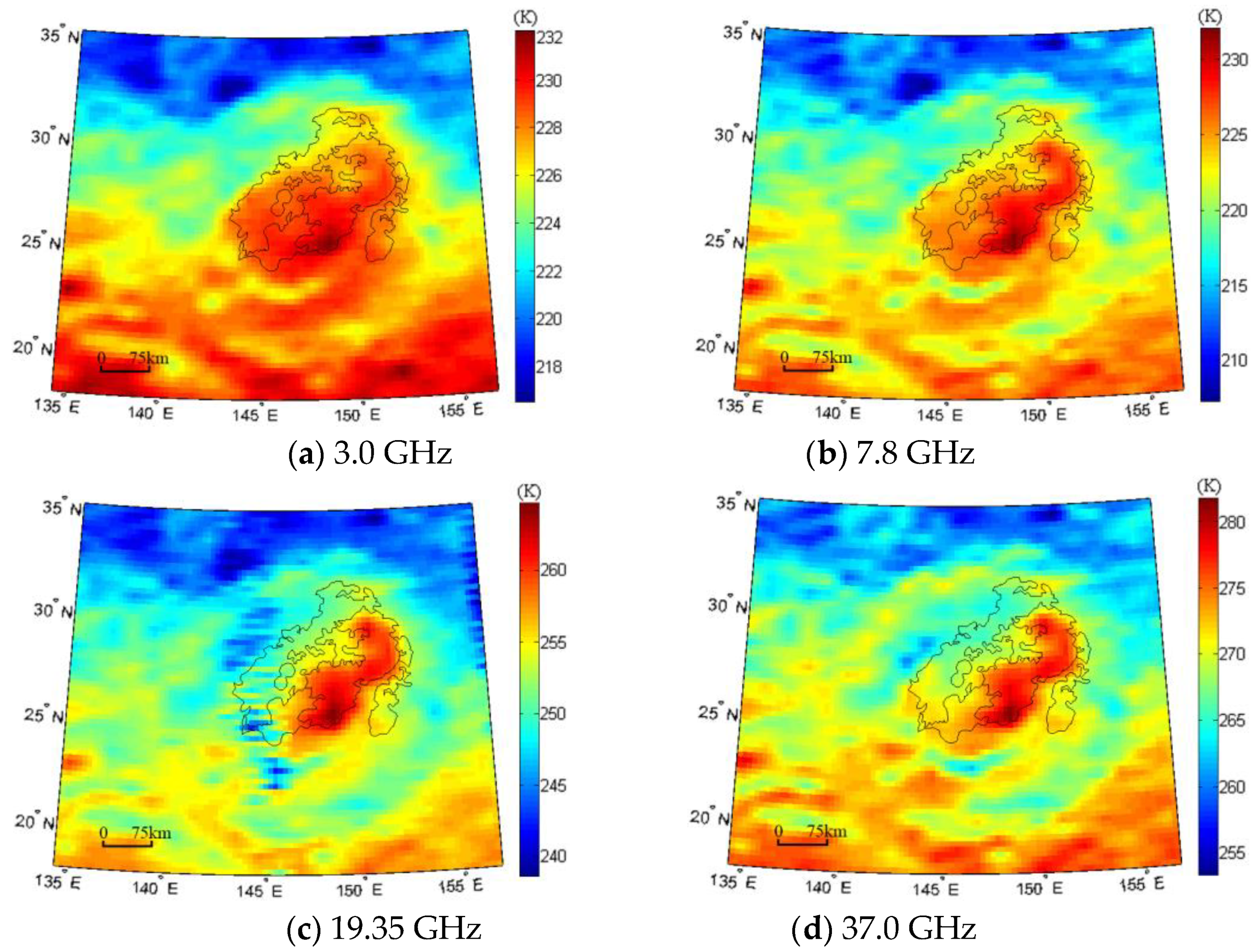

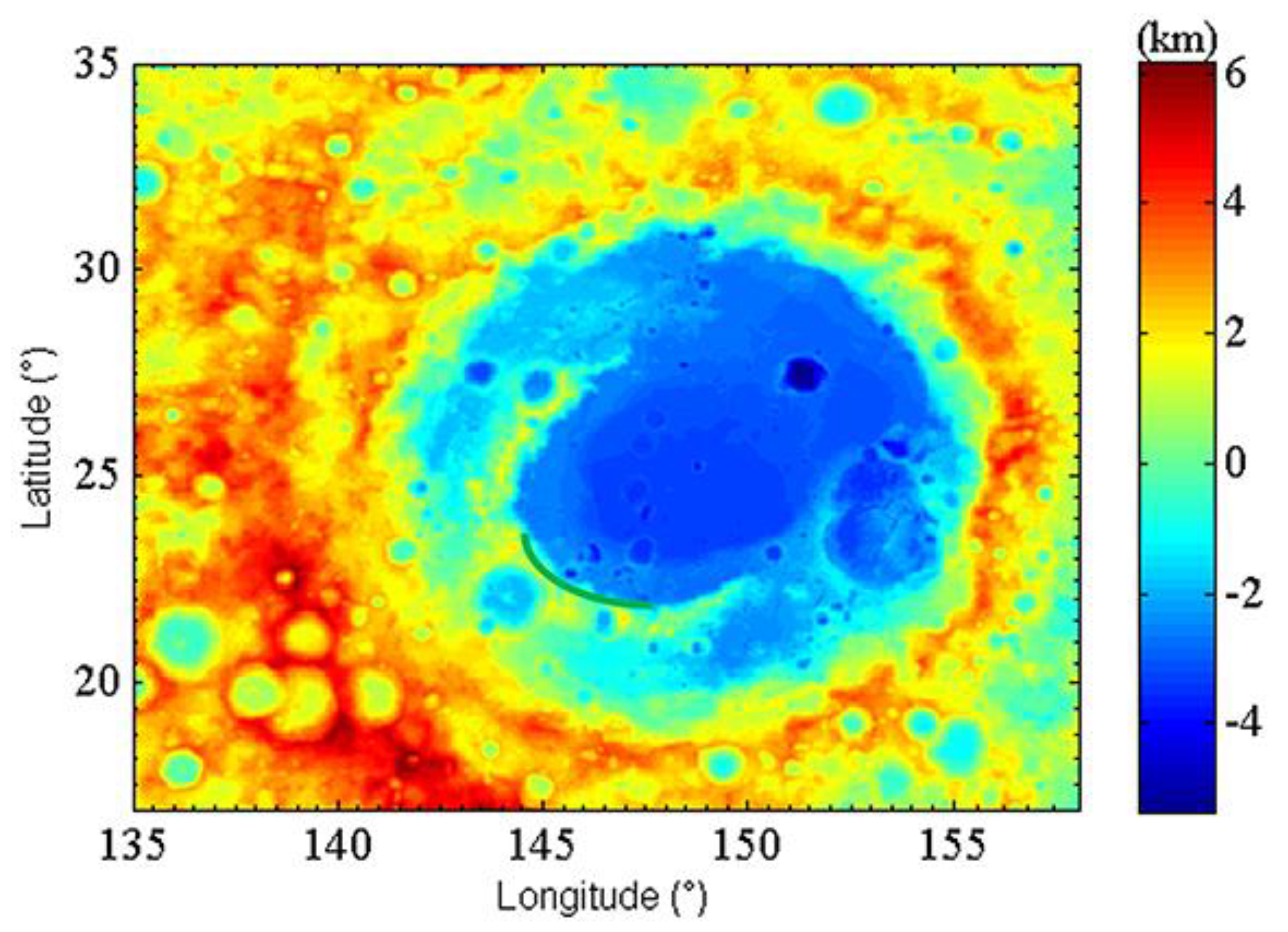

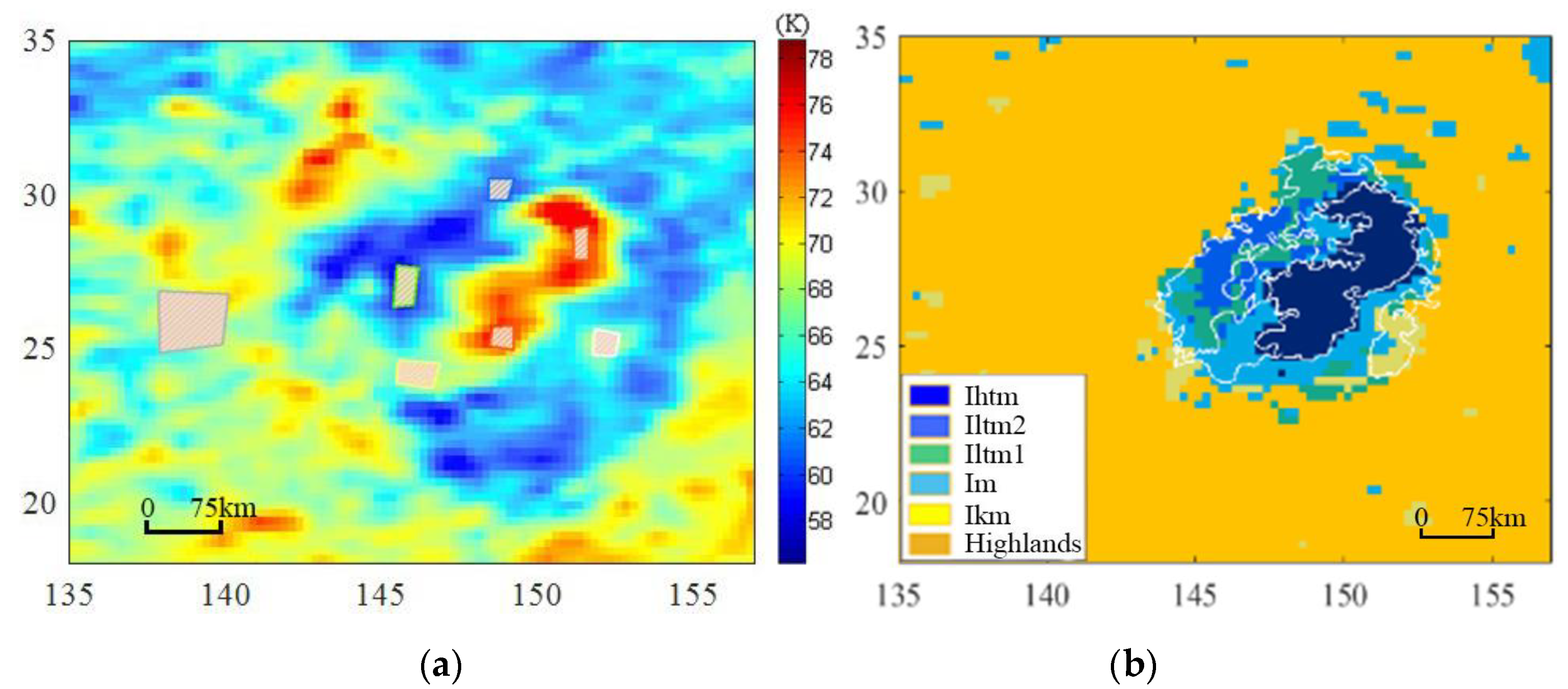


| Frequency (GHz) | Geologic Units | TB (K) | |||
|---|---|---|---|---|---|
| Maximum | Minimum | Average | Standard Deviation | ||
| 3.0 | Ihtm | 232.0 | 227.4 | 229.5 | 1.0 |
| Iltm | 229.3 | 224.6 | 227.3 | 1.2 | |
| Im | 230.5 | 226.5 | 228.6 | 0.9 | |
| Ikm | 228.8 | 226.4 | 227.6 | 0.6 | |
| 7.8 | Ihtm | 232.0 | 224.4 | 228.1 | 1.4 |
| Iltm | 225.6 | 219.3 | 223.0 | 1.6 | |
| Im | 227.6 | 221.7 | 225.0 | 1.2 | |
| Ikm | 225.4 | 221.3 | 222.9 | 1.1 | |
| 19.35 | Ihtm | 264.6 | 256.3 | 260.2 | 1.5 |
| Iltm | 256.2 | 247.3 | 251.9 | 1.8 | |
| Im | 259.9 | 242.6 | 253.8 | 3.6 | |
| Ikm | 255.4 | 251.7 | 253.3 | 1.0 | |
| 37 | Ihtm | 281.7 | 272.5 | 276.5 | 1.7 |
| Iltm | 271.4 | 264.5 | 267.6 | 1.6 | |
| Im | 275.5 | 267.4 | 271.9 | 1.5 | |
| Ikm | 272.4 | 268.4 | 270.5 | 1.1 | |
| Frequency (GHz) | Geologic Units | TB (K) | |||
|---|---|---|---|---|---|
| Maximum | Minimum | Average | Standard Deviation | ||
| 3.0 | Ihtm | 224.0 | 220.3 | 222.1 | 1.0 |
| Iltm | 224.3 | 220.1 | 222.3 | 1.1 | |
| Im | 224.8 | 220.3 | 223.5 | 1.1 | |
| Ikm | 224.3 | 222.4 | 223.3 | 0.6 | |
| 7.8 | Ihtm | 211.5 | 205.3 | 208.7 | 1.5 |
| Iltm | 212.6 | 205.0 | 208.8 | 1.5 | |
| Im | 212.3 | 204.7 | 210.3 | 1.6 | |
| Ikm | 212.1 | 208.0 | 210.0 | 1.0 | |
| 19.35 | Ihtm | 221.6 | 214.0 | 218.5 | 1.6 |
| Iltm | 222.7 | 216.4 | 219.8 | 1.5 | |
| Im | 222.5 | 216.1 | 220.6 | 1.5 | |
| Ikm | 222.7 | 218.6 | 220.4 | 1.0 | |
| 37 | Ihtm | 207.9 | 199.0 | 204.8 | 1.9 |
| Iltm | 211.3 | 202.2 | 207.2 | 2.1 | |
| Im | 210.2 | 201.8 | 207.9 | 1.7 | |
| Ikm | 208.6 | 202.7 | 205.4 | 1.5 | |
| Frequency (GHz) | Geologic Units | dTB (K) | |||
|---|---|---|---|---|---|
| Maximum | Minimum | Average | Standard Deviation | ||
| 3.0 | Ihtm | 8.4 | 5.7 | 6.9 | 0.5 |
| Iltm | 6.5 | 3.8 | 5.0 | 0.5 | |
| Im | 7.1 | 3.4 | 5.1 | 0.7 | |
| Ikm | 5.0 | 3.5 | 4.3 | 0.4 | |
| 7.8 | Ihtm | 22.8 | 16.0 | 19.4 | 1.4 |
| Iltm | 18.2 | 12.2 | 14.2 | 0.8 | |
| Im | 19.6 | 12.0 | 14.7 | 1.4 | |
| Ikm | 14.0 | 11.9 | 12.9 | 0.6 | |
| 19.35 | Ihtm | 46.9 | 37.3 | 41.7 | 1.9 |
| Iltm | 38.8 | 25.3 | 32.1 | 2.3 | |
| Im | 42.2 | 21.8 | 33.2 | 4.1 | |
| Ikm | 34.3 | 32.2 | 33.0 | 0.5 | |
| 37 | Ihtm | 78.8 | 66.7 | 71.7 | 2.4 |
| Iltm | 68.1 | 56.1 | 60.4 | 2.0 | |
| Im | 72.1 | 60.2 | 64.9 | 2.1 | |
| Ikm | 66.7 | 61.5 | 62.5 | 1.1 | |
© 2020 by the authors. Licensee MDPI, Basel, Switzerland. This article is an open access article distributed under the terms and conditions of the Creative Commons Attribution (CC BY) license (http://creativecommons.org/licenses/by/4.0/).
Share and Cite
Meng, Z.; Chen, S.; Wang, Y.; Wang, T.; Cai, Z.; Zhang, Y.; Zheng, Y.; Hu, S. Reevaluating Mare Moscoviense And Its Vicinity Using Chang’e-2 Microwave Sounder Data. Remote Sens. 2020, 12, 535. https://doi.org/10.3390/rs12030535
Meng Z, Chen S, Wang Y, Wang T, Cai Z, Zhang Y, Zheng Y, Hu S. Reevaluating Mare Moscoviense And Its Vicinity Using Chang’e-2 Microwave Sounder Data. Remote Sensing. 2020; 12(3):535. https://doi.org/10.3390/rs12030535
Chicago/Turabian StyleMeng, Zhiguo, Shengbo Chen, Yongzhi Wang, Tianxing Wang, Zhanchuan Cai, Yuanzhi Zhang, Yongchun Zheng, and Shuo Hu. 2020. "Reevaluating Mare Moscoviense And Its Vicinity Using Chang’e-2 Microwave Sounder Data" Remote Sensing 12, no. 3: 535. https://doi.org/10.3390/rs12030535
APA StyleMeng, Z., Chen, S., Wang, Y., Wang, T., Cai, Z., Zhang, Y., Zheng, Y., & Hu, S. (2020). Reevaluating Mare Moscoviense And Its Vicinity Using Chang’e-2 Microwave Sounder Data. Remote Sensing, 12(3), 535. https://doi.org/10.3390/rs12030535








